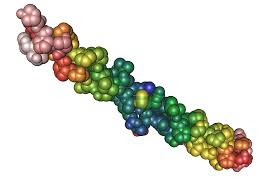A brief introduction to Protein Folding
The shape of a protein is vital to its function, carefully crafted, planned before it is needed and stored in the cells DNA.
 |
| Collagen - long and fibrous - makes up long microfibres in cells and a component in the skin. |
 |
| Haemoglobin - 4 proteins working together to transport oxygen around the blood. |
The primary structure of protein.
 |
| Click here to see an excellent animation. |
 |
| Click here to have a go yourself! |
Secondary Structure
The repeated intramolecular bonding between the backbone of the polypeptide. R groups are not involved.
Tertiary Structure
The overall three-dimensional structure of a polypeptide, produced by interactions between the side chains (R groups) of its amino acids, is called its tertiary structure.
The R group interactions that contribute to tertiary structure are diverse and include hydrogen bonding, ionic bonding, dipole-dipole interactions, and London dispersion forces – basically, the whole gamut of non-covalent bonds.
For example, two R groups with like charges will repel one another, while those with opposite charges can form an ionic bond. Similarly, polar R groups can form hydrogen bonds and other types of dipole-dipole interactions. Also important to tertiary structure are hydrophobic interactions, in which amino acids with nonpolar, hydrophobic R groups cluster together on the inside of the protein, leaving hydrophilic amino acids on the outside to interact with the surrounding water molecules. Although hydrophobic amino acids are driven to the interior of the protein by a desire to get away from water.
Have a go! What type of side chain interactions are shown below? (answers at the end but don't peak!)
A lot of help is required in the cell to help the protein fold correctly. It if does not fold correctly, it will not work.
Once the polypeptide is folded into its tertiary structure, it is called a protein.
Quaternary structure
When more than one protein associates together.
 |
| This elegant bacterial protein is involved in the folding of other proteins. It is 7 proteins working together. |
 |
| Our very own Haemoglobin |
How do scientists work it out? They use complex computer programs.
Detecting Proteins - Colorimetry

Answers to amino acid sidechain quiz. a) disulphide bond b)ionic bond aka salt bridge c)hydrogen bond d) hydrophobic interactions.












I appreciate how this blog highlights soya as a complete Vegan Protein Source. Many people still believe protein is only available in animal-based foods, but soya proves them wrong. It’s rich, nutritious, and can be cooked into so many tasty dishes. Personally, I use soy milk in my smoothies, tofu for curries, and soya chunks in salads – it’s cost-effective and keeps me full. Definitely a superfood for vegans and anyone looking to eat healthier!
ReplyDelete